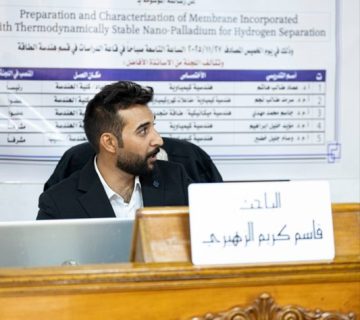The Chemical Engineering Department at the College of Engineering, University of Baghdad, held an PhD thesis examination titled:
” Performance of Sonoelectrochemical Technology in Refinery Wastewater Treatment“
On Sunday 1-9 -2024
By the student Hind Jabbar Nsaif and supervised by Prof. Dr. Najwa Saber Majeed and Asst. Prof. Dr. Rasha Habeeb Salman. The examination committee consisted of Prof. Dr. Wadood T. Mohammed as Chairman and the membership of Prof. Dr. Mohammed Sader Salman, Asst. Prof. Dr. Sarmad Talib Najim, Asst. Prof. Dr. Atheer M. AL-Yaqoob, and Asst. Prof. Dr.Shaymaa A. Ahmed.
After conducting the public discussion and listening to the student’s defense, the thesis was accepted. The thesis was summarized as follows:
The current study aims to investigate the use of sonoelectrochemical oxidation to remove organic contaminants from simulated wastewater.
Phenol is one of the worst-damaging organic pollutants, and it produces variety of very poisonous organic intermediates, therefor it is important to find efficient ways to remove it. One of the promising techniques is sonoelectrochemical processing, and selecting electrodes with a high efficiency and reasonable price is the biggest challenge. The main goal of the present study is to investigate the removal of phenol by sonoelectrochemical process with different anodes, graphite, stainless steel, and titanium electrodes. The best anode was tested by using the Taguchi design approach with L16 orthogonal array to optimize the degradation of phenol sonoelectrochemically with three process parameters: current density (CD) of 25, 50, 75, and 100 mA/cm2, time of 1, 2, 3, 4 h, and phenol concentration of 100, and 200 mg/l. Signal to noise (S/N) and analysis of variance (ANOVA) were utilized to examine the impact of each factor. The optimal conditions for phenol removal were 100 mA/cm2, 100 mg/l phenol concentration, and 4 h of electrolysis. Under optimal operating conditions, phenol was eliminated with 80.99% efficiency CD was the most influential factor on phenol elimination effectiveness, while the phenol concentration the least impact.
To improve Chemical oxygen demand (COD (removal, nano tin dioxide and nano composite tin-antimony oxide were electrochemically deposited cathodically on a graphite. The tin dioxide electrode was produced by cathodic electrodeposition using an SnCl2.2H2O solution in the presence of HNO3 and NaNO3 onto a graphite plate substrate. The impact of various operating parameters current density of 5, and 10 mA/cm2, HNO3 concentration of 150, and 250 mM, and SnCl2.2H2O concentration of 25, 50, 75, and 100 mM on the morphology and structure of the SnO2 deposit layer was thoroughly investigated. The tin-antimony dioxide composite electrode was prepared by cathodic deposition with SnCl2.2H2O solution in a mixture of HNO3 and NaNO3, with different concentrations of SbCl3 of 1, 2 and 4 g\l. The physical structures of the SnO2 and SnO2-Sb2O3 film were determined by Xray diffraction (XRD), surface morphology was characterized using scanning electron microscopy (SEM), and chemical composition was analyzed with energy-dispersive X-ray spectroscopy (EDX). In a batch reactor, the sonoelectrochemical oxidation of phenol was tested to determine the performance of the best SnO2 electrodes for phenol degradation and any organic byproducts by detecting COD. It was discovered that the 10 mA/cm2, 50 mM of SnCl2.2H2O, and 250 mM of HNO3 were the optimum conditions to prepare SnO2 electrodes, which produced the smallest crystal size, with no appeared cracks, and gave the best COD removal. The best prepared electrode was tested in the sonoelectrochemical oxidation of phenol with two different electrolytes and different CD, and the results showed that the COD removal efficiency was 69.68% and 51.87% when using NaCl and Na2SO4, respectively, and was 63.39, 76.87, and 100% for CD at 10, 25, and 40 mA/cm2, respectively. The SnO2-Sb2O3 deposit layer’s structure and morphology were examined and the 4 g/l SbCl3 gave the more crystallized with nanoscale electrodeposition. The results showed that SbCl3 concentration is an important factor in the electrocatalytic activity of SnO2-Sb2O3 nanocomposite electrodes. The highest removal of COD was obtained with SnO2- Sb2O3 nanocomposite electrode with 4 g/l SbCl3 concentration, where COD removal % was 69.33, 71.59, 75.79, and 100% for SnO2 electrode, SnO2-Sb2O3 electrode with 1 g/l, SnO2-Sb2O3 electrode with 2 g/l, and SnO2-Sb2O3 electrode with 4 g/l SbCl3 concentration, respectively, at CD of 25 mA/cm2, initial phenol concentration of 150 mg/l, temperature of 30°C, pH of 3, NaCl concentration of 3 g/l, ultrasonic frequency of 40 kHz, and time of electrolysis is 4 h. The SnO2-Sb2O3 electrode was tested by using the Taguchi design approach with L18 orthogonal array to optimize the degradation of phenol sonoelectrochemically with four process parameters: initial phenol concentration of 100, and 200 mg/l, temperature of 30, 40, and 50 °C, CD of 10, 20, and 25 mA/cm2, and time of 1, 2, and 3 h. Based on ANOVA and S/N results, time was the most influential factor on phenol elimination effectiveness, while the phenol concentration the least impact, the highest removal of phenol and COD was 100 % at a temperature of 30°C, with current density (CD) of 25 mA/cm2 , 100 mg/l phenol concentration, and time of electrolysis is 3 h.
The study recommended Using SnO2-Sb2O3 composite electrodes for removal various types of organic contaminants, such as oily, and pharmaceutical wastewater, using SnO2-Sb2O3 composite electrodes in other combined method such as electroxidation and electrocoagulation, Using continuous mode and compared with results of the batch operation for each process in the present work, and electrodeposition of more than two oxide (such as SnO2-Sb2O3 and PbO2) on the graphite substrate (composite anode electrode) to improve its removal efficiency.

Comments are disabled.







